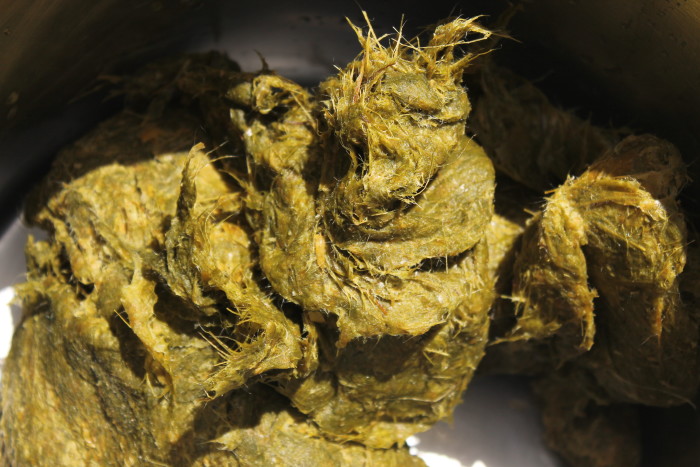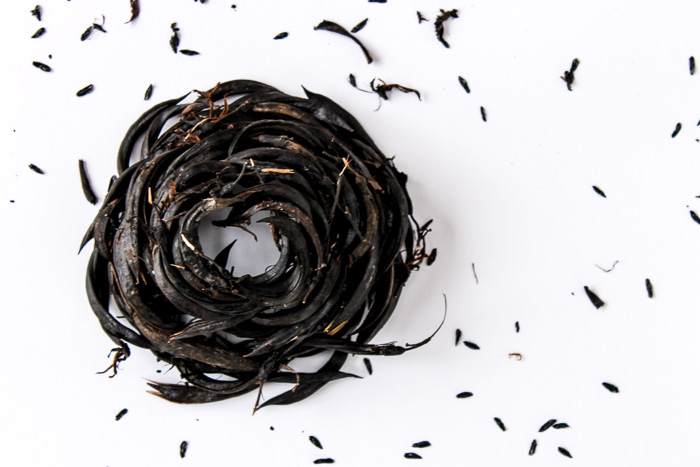It is amazing to work with such a versatile plant, harakeke (engl. flax, phormium tenax) is not only such a valuable plant for weaving, rope making and medicinal use to name a few. You can make paper out of 100 percent harakeke fibres. During this years studies I have the opportunity to learn to make harakeke paper.
I used my waste bits from harvesting for weaving, cutting pieces about 1 to 2cm long (its a very time intense occupation,). I cut about 500g and soaked the whole lot for about 48 hours in water. Then it had to be boiled with in water with added soda ash (I used washing crystals from the supermarket).
boiling harakeke
Boiled for about 3 hours, it depends on the harakeke how long it needs to be boiled, important is that the leaf starts to fall to bits. Finished that, I rinsed it well till the leaves dont feel slimy anymore. Afterwards it goes into the flax beater (Hollander) which beats the fibres till its ready to use (it took about 20 min).
Clare and the hollander (beater)
I personally like to have it beaten so there are still fibers visible.
The pulp is then ready for the actual paper making. It took a bit to figure out the proportion of water to pulp, I guess its personal preference and depending on the use if you want to have thicker or thinner paper.
yummy pulp
These are a few examples of my paper, which I will use in my art work. I didnt size my paper as I dont intend to write on it at that stage.
detail harakeke paper, so gorgeous

eco printed silk stitched on harakeke paper

dyed akeake leaf embedded in harakeke paper

just lovely crunched up paper (crunched wet and let dry so it keeps the shape)

a simple sheet
ephemeral seed pod sculptures
If you haven’t seen the breathtaking sculptures of Andy Goldsworthy you must do now. His work is so beautiful, fragile, strong, soft, hard. Its so inspirational that I had to go in my studio to have a play with some kowhai and harakeke (NZ flax) seed pods. I made them for the moment to enjoy and to give them back to the bush afterward.


I was very pleased with my little seed pods sculptures, making them was also very calming and relaxing.

Fibre Arts New Zealand workshop in Whanganui
Just came back from a 5 days workshop in Whanganui to meet the lovely Australian artist Meredith Woolnough and to learn some of her sewing techniques.
Here are some of her samples she brought to show us. She basically sews with her sewing machine using the free motion food onto soluble paper which will wash away later. This way she creates wonderful fragile flat or sulptural pieces she frames or put in resin.


I had a few arguments with my new sewing machine as I haven’t done hardly any machine sewing in my life but just when I lost confidence in her (and me) the magic happened: I did my first sculpture, some threads are lost and hanging loose but I still like my very organically looking shape and the shadows.
At the end of the week we had a little exhibition showcasing everybody’s lovely works. It was a week full of learning, sharing and fun thanks to the organizers Trisha and Julz, the tutors, and the crew from Ad astra hostel. Sure I will be back next year!
Making Harakeke Paper
It is amazing to work with such a versatile plant, harakeke (engl. flax, phormium tenax) is not only such a valuable plant for weaving, rope making and medicinal use to name a few. You can make paper out of 100 percent harakeke fibres. During this years studies I have the opportunity to learn to make harakeke paper.
I used my waste bits from harvesting for weaving, cutting pieces about 1 to 2cm long (its a very time intense occupation,). I cut about 500g and soaked the whole lot for about 48 hours in water. Then it had to be boiled with in water with added soda ash (I used washing crystals from the supermarket).
boiling harakeke
Boiled for about 3 hours, it depends on the harakeke how long it needs to be boiled, important is that the leaf starts to fall to bits. Finished that, I rinsed it well till the leaves dont feel slimy anymore. Afterwards it goes into the flax beater (Hollander) which beats the fibres till its ready to use (it took about 20 min).
Clare and the hollander (beater)
I personally like to have it beaten so there are still fibers visible.
The pulp is then ready for the actual paper making. It took a bit to figure out the proportion of water to pulp, I guess its personal preference and depending on the use if you want to have thicker or thinner paper.
yummy pulp
These are a few examples of my paper, which I will use in my art work. I didnt size my paper as I dont intend to write on it at that stage.
detail harakeke paper, so gorgeous
eco printed silk stitched on harakeke paper
dyed akeake leaf embedded in harakeke paper
just lovely crunched up paper (crunched wet and let dry so it keeps the shape)
a simple sheet
Harakeke Earrings
A play with Indigo
I love colour! And I got this white cotton blouse from the second hand shop, and I had this indigo project in mind (one of the 192 projects I plan to do).
Summer and high temperatures, the perfect weather to start an Indigo Vat. I used the fruit vat method (over ripe bananas, indigo powder and calcium hydroxide/lime) from Maiwa. Easy to follow.
I folded and bound the back of the blouse into a spider web pattern (kumo shibori) and for the sleeves I bound kowhai seeds to achieve a nice delicate pattern (ne maki shibori). After several dips into the indigo vat, my blouse made this beautiful transformation.
I also disscovered that the rusty looking colour on the sleeves comes from the kowhai seeds I drilled holes in before…
The other day in the shed…
Summertime and our 5 sheep needed a haircut. Susi is the boss of a group of 5 sheep and a very gorgeous Gotland mix.
Said, done.
This is the very nice fleece of Susi:
After washing and carding, this is the result. The wool is coarser than merino wool but it works really well for sculptural felt.
Testing the colour from Barberry
For a quite a while I’ve known that Barberry (Berberis vulgaris) has bright yellow bark and I’ve been keen to test their dye properties. Luckily enough, a few days ago I heard that my neighbours were cutting down their barberry bushes, so I used the opportunity to harvest some bark.
After soaking some bark in water (just enough to cover the bark) overnight.

I let the pot simmer for about an hour before I removed the bark to avoid uneven dyeing and plant matters in the fabrics. Fabrics soaked in water and then immersed. For each test I dissolved less than half a teaspoon alum and iron, and for the copper mordants I used a copper plate (any piece of copper will do, or even a copper pot if available – the old New Zealand 10 cent coin contains copper as well). These mordents help to fix the colour into the fabric.
I left the fabrics in the pot till the next morning and here are the results:
I did some shibori resist dye (ne-maki shibori) on the merino fabric, using kowhai seeds. The yellow of the inner circle seems to be stronger, so I assume that the kowhai seeds released some dye as well, love the delicate pattern.
Through my research I found out that the berries are also edible (a sour taste) and also can be used to dye fibres. I will have to wait till autumn to harvest some of those berries. You will hear from me!
I am really pleased with the depth of tone and will certainly use it for coming projects.
Welcome to my blog!
Haere mai ki taku ao!
My name is Birgit Moffatt and I am a visual art student now in my third year. I live on the foothills of the Tararua Ranges close to native bush and the Ōtaki River in the lower North Island of Aotearoa/New Zealand. I would love to share my experiences and discoveries relating to fibre and textile with you.
Feedback is very welcomed.
A new day
Come and join me on my journey through the world of fibres!
Entry without preview image
Lorem ipsum dolor sit amet, consectetuer adipiscing elit. Aenean commodo ligula eget dolor. Aenean massa. Cum sociis natoque penatibus et magnis dis parturient montes, nascetur ridiculus mus. Donec quam felis, ultricies nec, pellentesque eu, pretium quis, sem.
Nullam dictum felis eu pede mollis pretium. Integer tincidunt. Cras dapibus. Vivamus elementum semper nisi. Aenean vulputate eleifend tellus. Aenean leo ligula, porttitor eu, consequat vitae, eleifend ac, enim. Aliquam lorem ante, dapibus in, viverra quis, feugiat a, tellus.
Read more